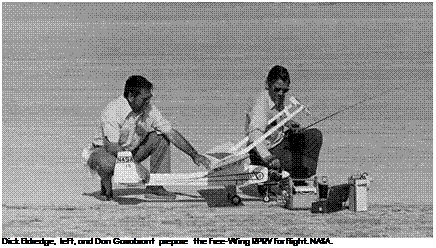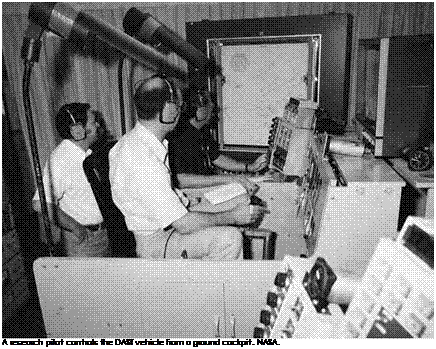Exploring the Torsionally Free Wing
Aeronautical researchers have long known that low wing loading contributes to poor ride quality in turbulence. This problem is compounded by the fact that lightweight aircraft, such as general aviation airplanes, spend a great deal of their flight time at lower altitudes, where measurable turbulence is most likely to occur. One way to improve gust alleviation is through the use of a torsionally free wing, also known as a free wing.
The free-wing concept involves unconventional attachment of a wing to an airplane’s fuselage in such a way that the airfoil is free to pivot about its spanwise axis, subject to aerodynamic pitching moments but otherwise unrestricted by mechanical constraints. To provide static pitch stability, the axis of rotation is located forward of the chordwise aerodynamic center of the wing panel. Angle-of-attack equilibrium is established through the use of a trimming control surface and natural torque from lift and drag. Gust alleviation, and thus improved ride quality, results from the fact that a stable lifting surface tends to maintain a prescribed lift coefficient by responding to natural pitching moments that accompany changes in airflow direction.[923] Use of a free wing offers other advantages as well. Use of full-span flaps permits operation at a higher lift coefficient, thus allowing lower minimum-speed capability. A free stabilizer helps eliminate stalls. Use of differentially movable wings instead of ailerons permits improved roll control at low speeds. During takeoff, the wing rotates for lift-off, eliminating pitching movements caused by landing-gear geometry issues. Lift changes are accommodated without body-axis rotation. Because of independent attitude control, fuselage pitch can be trimmed for optimum visibility during landing approach. Negative lift can be applied to increase deceleration during
 |
|
landing roll. Fuselage drag can be reduced through attitude trim. Finally, large changes in the center of gravity do not result in changes to longitudinal static stability.[924] To explore this concept, researchers at NASA Dryden, led by Shu Gee, proposed testing a radio-controlled model airplane with a free-wing/free-canard configuration. Quantitative and qualitative flight-test data would provide proof of the free-wing concept and allow comparison with analytical models. The research team included engineers Gee and Chester Wolowicz of Dryden. Dr. Joe H. Brown, Jr., served as principal investigator for Battelle Columbus Laboratories of Columbus, OH. Professor Gerald Gregorek of Ohio State University’s Aeronautical Engineering Department, along with Battelle’s Richard F. Porter and Richard G. Ollila, calculated aerodynamics and equations of motion. Battelle’s Professor David W. Hall, formerly of Iowa State University, assisted with vehicle layout and sizing.[925] Technicians at Dryden modified a radio-controlled airplane with a 6-foot wingspan to the test configuration. A small free-wing airfoil was rigidly mounted on twin booms forward of the primary flying surface. The ground pilot could change wing lift by actuating a flap on the free wing for longitudinal
control. Elevators provided pitch attitude control, while full-span ailerons were used for roll control.
For data acquisition, the Free-Wing RPRV was flown at low altitude in a pacing formation with a ground vehicle. Observers noted the positions of protractors on the sides of the aircraft to indicate wing and canard position relative to the fuselage. Instrumentation in the vehicle, along with motion picture film, allowed researchers to record wing angle, control-surface positions, velocity, and fuselage angle relative to the ground. Another airplane model with a standard wing configuration was flown under similar conditions to collect baseline data for comparison with the Free-Wing RPRV performance.[926]
Researchers conducted eight flights at Dryden during spring 1977. They found that the test vehicle exhibited normal stability and control characteristics throughout the flight envelope for all maneuvers performed. Pitch response appeared to be faster than that of a conventional airplane, apparently because the inertia of the free-wing assembly was lower than that of the complete airplane. Handling qualities appeared to be as good or better than those of the baseline fixed-wing airplane. The investigators noted that separate control of the decoupled fuselage enhanced vehicle performance by acting as pseudo-thrust vectoring. The Free-Wing RPRV had excellent stall/spin characteristics, and the pilot was able to control the aircraft easily under gusty conditions. As predicted, center of gravity changes had little or no effect on longitudinal stability.[927] Some unique and unexpected problems were also encountered. When the canard encountered a mechanical trailing – edge position limit, it became aerodynamically locked, resulting in an irreversible stall and hard landing. Increased deflection limits for the free canard eliminated this problem. Researchers had difficulty matching the wing-hinge margin (the distance from the wing’s aerodynamic center to the pivot) and canard control effectiveness. Designers improved handling qualities by increasing the wing hinge margin, the canard area aft of the pivot, and the canard flap area. Canard pivot friction caused some destabilizing effects during taxi, but these abated during takeoff. The ground pilot experienced control difficulty
 |
|
because wing-fuselage decoupling made it difficult to visually judge approach and landing speeds, but it was concluded that this would not be a problem for a pilot flying a full-scale airplane equipped with conventional flight instruments.[928]










